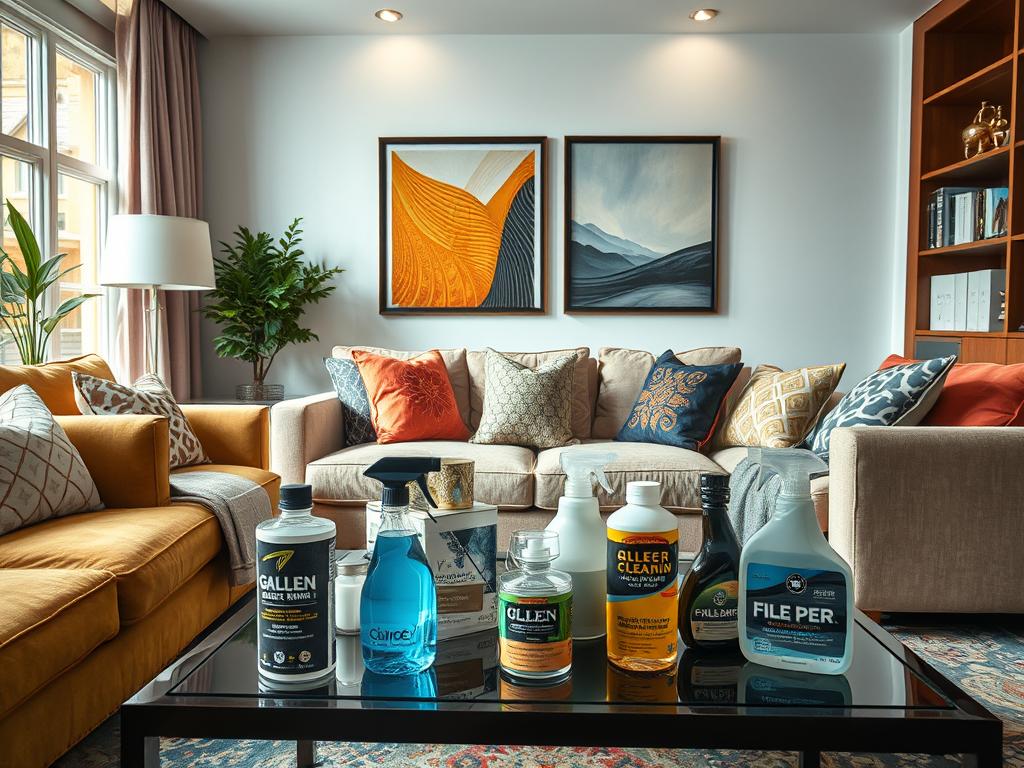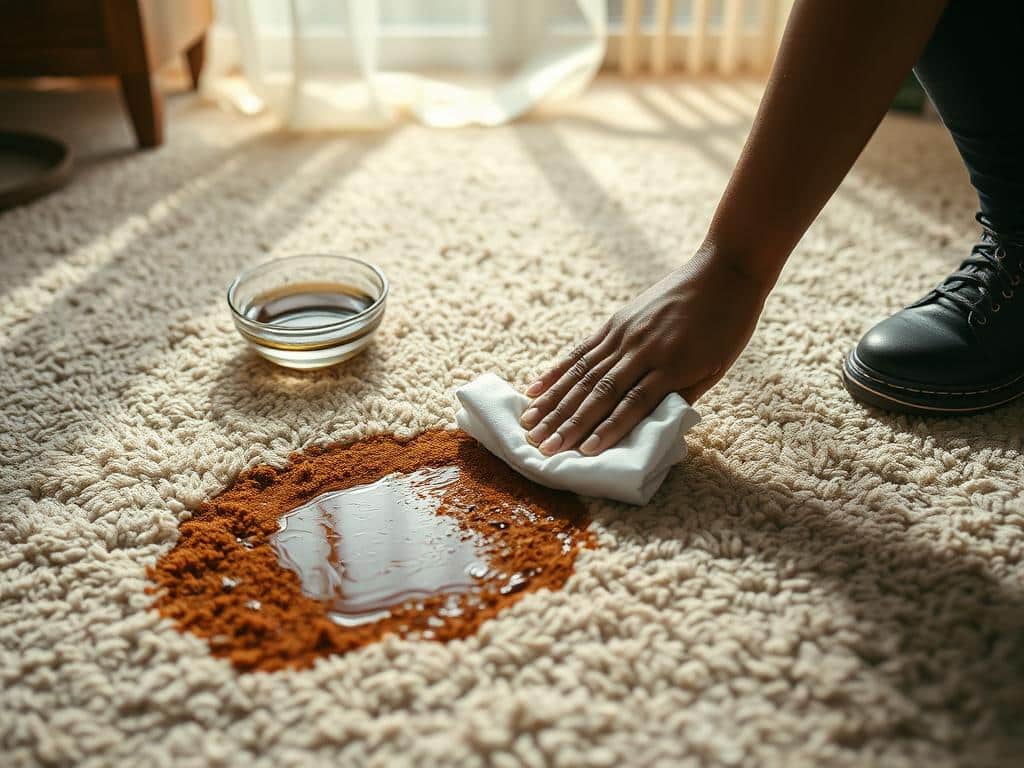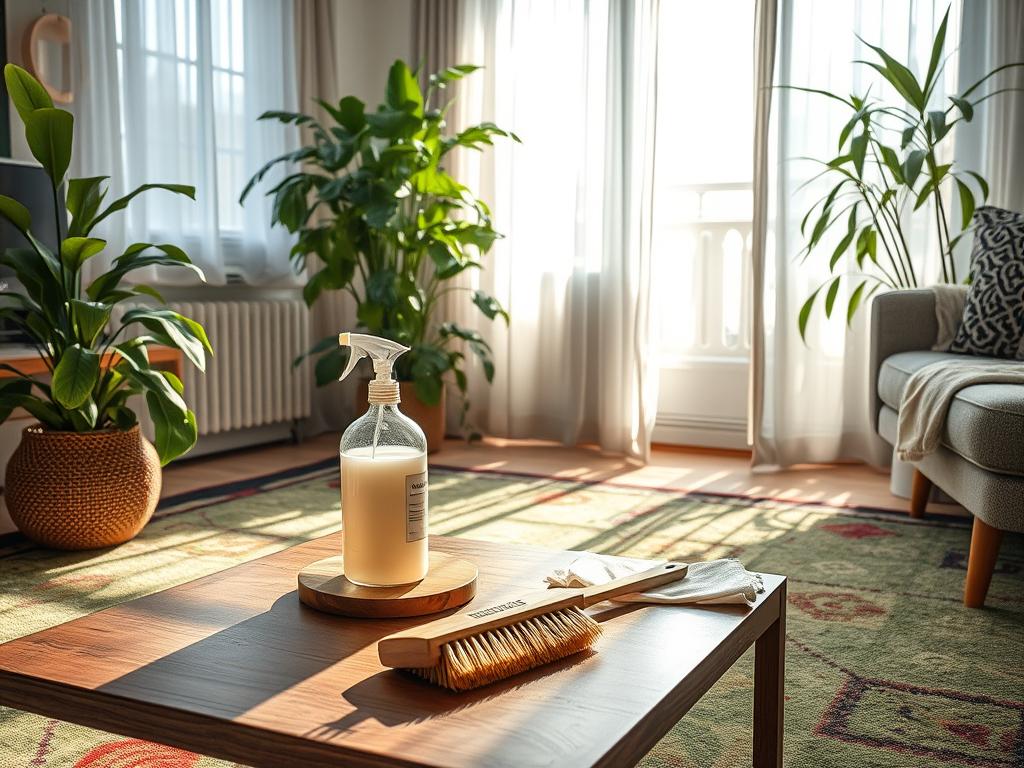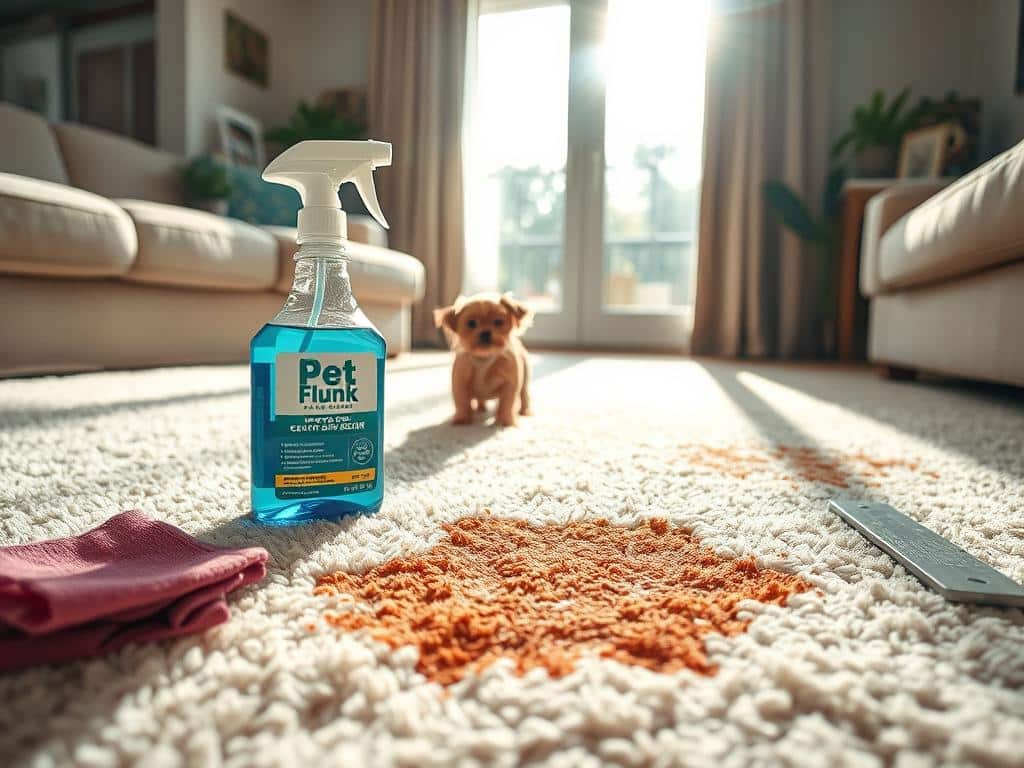
As a pet owner, you know how annoying pet stains on carpets can be. You might face urine, vomit, or other messes. Thankfully, you don’t always need pros or strong cleaners to fix this.
One great way to clean carpets uses things like baking soda and vinegar. This method works well on both new and old stains. People like it because it removes stains and smells. It’s also safe for pets and our planet.
For tough smells, enzyme cleaners are a good choice. They target biological stuff, which makes them great against pet smells. Products like Folex are top picks for dealing with old stains, including urine ones.
Dealing with a pet stain fast stops it from getting worse. The vinegar and baking soda method is a good starting point. This guide will show you how to handle these stains. You’ll keep your carpets looking and smelling fresh.
Understanding Different Types of Pet Stains
Pet accidents on carpets can vary in severity and type. They need quick and appropriate action for effective carpet restoration. Each type of stain has its own challenges. However, with the right cleaning solutions, you can tackle them efficiently.
Urine Stains
Urine stains are common and can damage carpets if not cleaned quickly. Fresh urine has a pH of around 6. But as it dries, it becomes highly alkaline, with a pH above 10. This turns into crystals that stick to carpet fibers. Quick removal is key to avoid permanent damage and bad smells from ammonia.
To better the cleaning process, pre-treat fresh stains with bio laundry detergent before machine washing.
Poop Stains
Poop stains are easy to see and tough to clean. They contain solid food remains, nitrates, sulfates, and harmful bacteria. A mix of bio laundry detergent and a bio enzyme booster works well for cleaning. This method cleans and removes possible health risks from pet accidents.
Vomit Stains
Vomit stains can discolor carpet fibers quickly because they’re acidic. First, blot the vomit. Then, pre-treat the area with baking soda to neutralize the acid. Clean thoroughly with the right agents for effective carpet restoration. Vomit stains are hard because they have protein and enzymes. Yet, careful cleaning leads to good results.
Knowing the types of pet stains and their makeup helps in creating targeted cleaning solutions. Whether it’s urine, poop, or vomit, each requires a specific way to clean for proper carpet restoration. Quick action and the right methods prevent damage and keep your carpet in good condition.
How to Remove Pet Stains from Carpet: A Step-by-Step Guide
Getting rid of pet stains on your carpet requires the right supplies and a planned approach. This guide walks you through the steps. It ensures your carpet stays clean and free of smells.
Materials You’ll Need
- Paper towels or clean cloths
- White vinegar
- Baking soda
- Vacuum cleaner
Blotting the Stain
Start by blotting the stain gently with paper towels or a clean cloth. Don’t rub, just press softly to soak up liquid. This preps the area well for the next cleaning steps.
Applying Vinegar Solution
Then, make a mix of water and white vinegar in equal parts. Drench the stain with this mix. Let it work for 5 to 10 minutes. This lets the vinegar act on the pet urine stain effectively.
Using Baking Soda
After the vinegar has done its job, cover the area with baking soda. This combination lifts the stain and fights smells. It’s great for both cleaning stains and getting rid of odors.
Vacuuming the Area
When the baking soda is dry, vacuum up all residue well. This finishes the cleaning and leaves your carpet fresh. To learn more about pet stain removal and other tips, visit this guide.
If you keep having carpet issues, think about getting professional help for $100 to $250. Carpets with stain resistance or types like Nylon and Olefin can be better choices for pet owners. Taking care of your carpet by vacuuming and getting it professionally cleaned from time to time is important.
Dealing with Stubborn Odors: Enzyme Cleaners and Alternatives
Enzyme cleaners are great for getting rid of pet smells. They work by breaking down the smelly proteins. Knowing how to use them right makes them even better. You can also find natural ways to get rid of bad smells.
What Are Enzyme Cleaners?
Enzyme cleaners break down organic stuff, which helps get rid of smells. They’re not as quick as chemical cleaners and need time to work. Temperature and pH can affect how well they work.
How to Use Enzyme Cleaners
Clean the area first to get rid of dirt. Then, put a lot of the enzyme cleaner on it. Let it sit as the label says so it works well. For quicker results, try Skout’s Honor, which isn’t bothered by environment.
Homemade Alternatives
Want to try making your own cleaner? Diluted vinegar or hydrogen peroxide with dish soap are good. Be careful to avoid stains or dirt-attracting residues. Always do a patch test first. Don’t use ammonia; it can attract pets back to the spot.
Adding enzyme cleaners or homemade remedies to your routine can change how you fight pet smells. Choose between special products or DIY mixes. Either way, apply them carefully and regularly. For more on keeping furniture clean, click here for tips.
Preventing Future Pet Stains on Your Carpet
Keeping pet stains off your carpet makes your home cleaner and healthier. You need to combine proactive steps with good pet training.
Quick cleaning is key. If you act fast, you can often get your carpet looking good again after a stain. Use a wet vac to lift pet stains by pushing clean water into the carpet and sucking out the dirty water. After cleaning, use a top-notch pet odor neutralizer.
Training your pets well can also protect your carpet and make it last longer. Using positive reinforcement can help teach your pets to avoid accidents. Seeing a vet to check for health problems is a good step too. If your pet keeps having issues, a professional trainer might help.
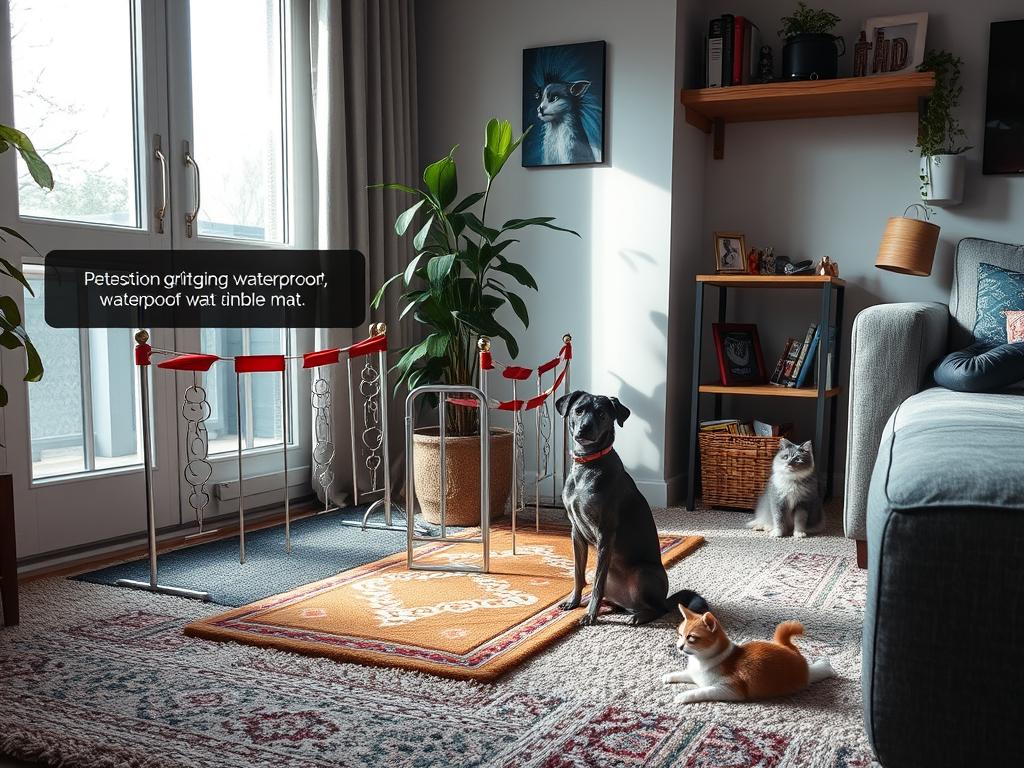
Setting up specific spots for your pets can lower stain risks. Having the right cleaners and carpet protectors ready is crucial. Paying attention to your pet’s behavior signs can prevent mishaps too.
Here are extra steps for keeping your carpets stain-free:
- Get enzyme-based stain and odor removers.
- Wash pet bedding often to stop stains and smells.
- Choose pet vacuums that have strong suction and brushes.
- Use lint rollers or brushes to pick up pet hair.
- Train pets for certain potty spots. For cats, have one litter box per cat plus one; clean them every day.
By taking these actions, you can keep your home clean and your carpets in top shape.
Conclusion
Dealing with pet stains might seem tough, but it gets easier with the right pet stain solutions. It is crucial to act fast for the best cleaning results. Quick steps help soak up extra liquid and stop stains from setting.
Using vinegar and baking soda helps break down stains and get rid of smells. This mix keeps your carpets fresh and clean. It’s also important to know the different types of pet stains. Products like enzyme cleaners are great for hard stains and smells. These cleaners need time to work on the proteins in stains.
Preventive actions are key to a clean home. Keeping up with vacuuming, washing pet beds, and pet training helps a lot. If stains are tough, think about getting professional help. Sticking with these cleaning steps will make your home clean and welcoming for both you and your pets.

